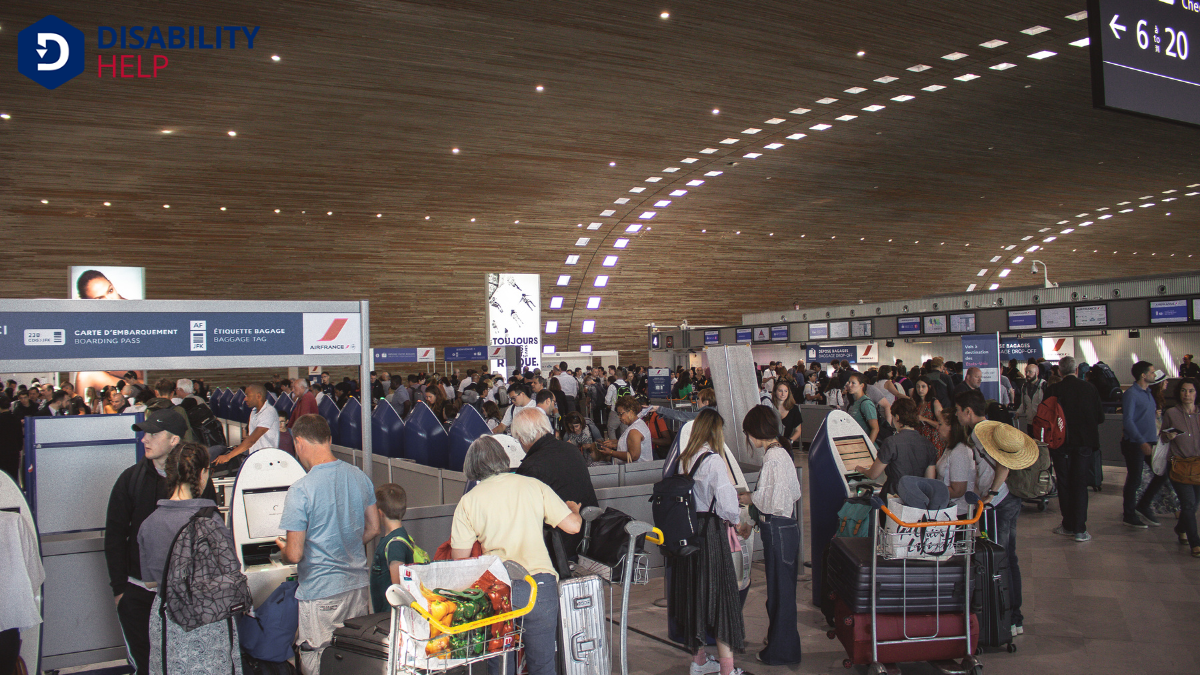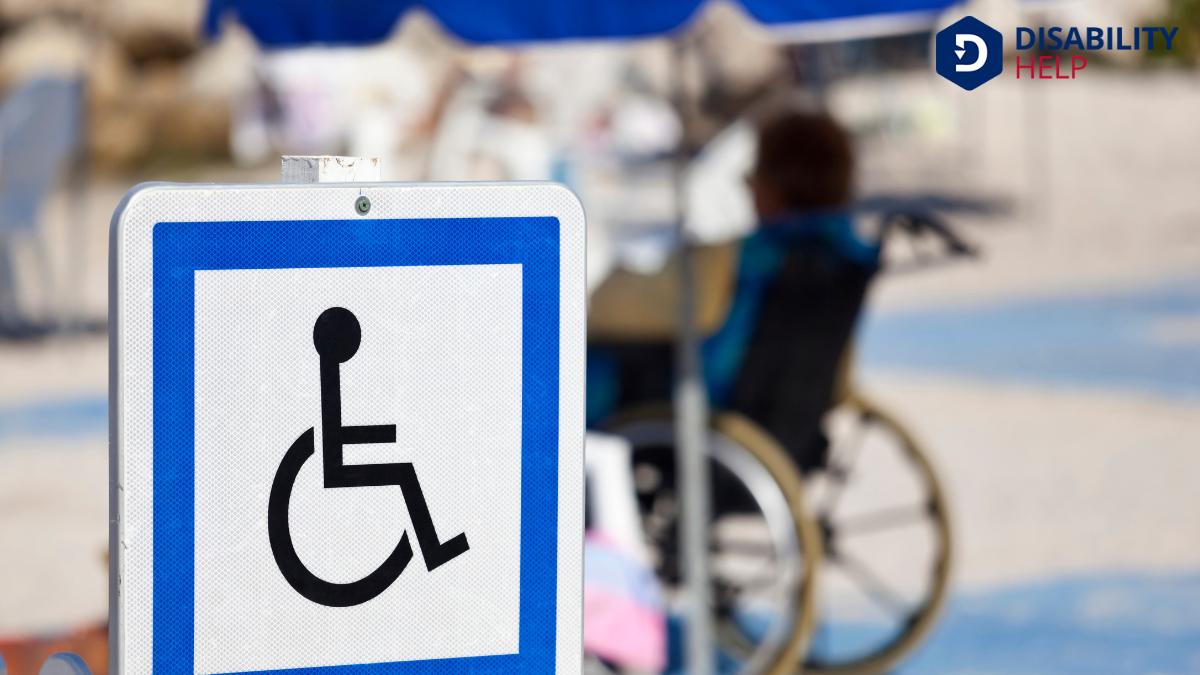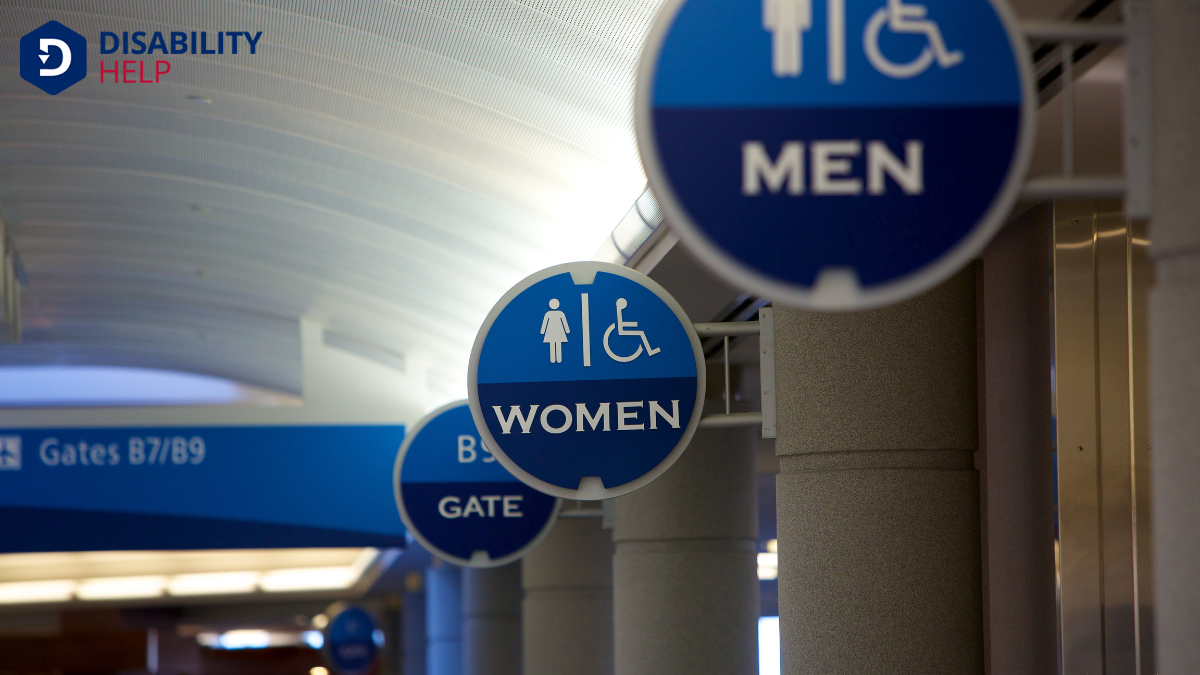We often find ourselves wondering whether airports are genuinely required to assist disabled travelers, especially given the complexities of travel. Under the Americans with Disabilities Act (ADA)A U.S. law that prohibits discrimination against individuals with disabilities in all areas of publi... and the Air Carrier Access Act (ACAA), airports must provide necessary accommodationsModifications or adjustments in healthcare settings to support patients with disabilities.. But how well do they actually implement these requirements? Let’s explore the realities and challenges of airport accessibilityThe design of products, devices, services, or environments to be usable by people with disabilities.... and what this means for travelers with disabilities.
Key Takeaways
- Yes, airports are required to provide assistance to disabled travelers under the Americans with Disabilities Act (ADA).
- The Air Carrier Access Act (ACAA) mandates non-discriminatory travel services for individuals with disabilities.
- Airport authorities must maintain accessible facilities, including pathways and restrooms, for travelers with disabilities.
- Airlines are responsible for providing accessible seating and assistance with boarding processes.
- Staff training on handling assistance requests is legally required to ensure professional service for disabled travelers.
Understanding the Legal Framework for Airport Accessibility
When we consider airport accessibility, it’s essential to first understand the legal framework that guarantees equal accessThe principle that all individuals, including those with disabilities, should have equal opportunity... for disabled travelers. We’re looking at laws like the Americans with Disabilities Act (ADA) in the U.S., which guarantees that airports provide necessary accommodations.
The Air Carrier Access Act (ACAA) specifically addresses air travel, prohibiting discrimination on the basis of disability. These laws require airports to offer services such as wheelchair assistance, accessible restrooms, and proper signage.
We need to be aware that these regulations demand training for airport staff to handle assistance requests professionally. It’s our responsibility to know our rights and communicate our needs to facilitate smooth travel experiences.
Understanding this framework helps us advocate for ourselves and others, making air travel fair and accessible for everyone.
Key International Guidelines and Standards

As we explore how airports can better assist disabled travelers, we should consider key international guidelines and standards.
The UN Convention sets foundational requirements, while the IATA and ICAO provide additional policies and guidelines that shape accessibility practices globally.
UN Convention Requirements
Although many travelers face challenges, those with disabilities often encounter unique obstacles at airports. The UN Convention on the Rights of Persons with Disabilities (CRPD)An international treaty that promotes and protects the rights of people with disabilities. sets international standards to guarantee their dignified travel.
As a global community, we must acknowledge these requirements to foster inclusivity. Here are three key aspects of the CRPD that resonate with us:
- Equality and Non-Discrimination: All passengers should receive fair treatment without prejudice, guaranteeing accessibility for everyone.
- Accessibility: Airports must adaptA grassroots disability rights organization in the U.S. that focuses on promoting community-based se... facilities and services to accommodate diverse needs, allowing seamless travel experiences.
- Participation and InclusionThe practice of creating environments in which any individual or group can be and feel welcomed, res...: Involving disabled travelers in decision-making processes helps tailor services to real needs.
IATA Accessibility Policies
Understanding the importance of accommodating all travelers, the International Air Transport Association (IATA) has established accessibility policies designed to harmonize airport services worldwide. These policies guarantee that disabled travelers receive consistent and respectful assistance regardless of their destination. By setting these standards, IATA aims to foster an inclusive travel environment, emphasizing communication and collaboration among airlines and airports.
We should recognize that IATA's guidelines address key areas such as boarding, security checks, and in-flight support. They promote staff training tailored to understanding and assisting various disabilities, guaranteeing that travelers feel supported and informed throughout their journey.
As we navigate air travel, IATA's commitment to accessibility highlights the importance of equal access and dignity for all passengers, making travel more seamless and enjoyable.
ICAO Disability Guidelines
While maneuvering through the complexities of air travel, it's crucial to take into account the International Civil Aviation Organization's (ICAO) Disability Guidelines, which set key international standards for assisting travelers with disabilities.
These guidelines guarantee a respectful and inclusive experience for all passengers, emphasizing dignity and equality. They serve as a beacon of hope, reminding us of our shared commitment to accessibility.
Let's consider how these guidelines impact our travel experiences:
- EmpowermentThe process of gaining control, authority, and power over one’s life, often used in the context of...: They empower travelers with disabilities, guaranteeing they've the same opportunities and access as everyone else.
- Awareness: They increase awareness among airport staff about the needs of disabled travelers, fostering a supportive environment.
- Consistency: They guarantee consistent and reliable assistance across airports worldwide, reducing uncertainty and anxiety for travelers.
The Role of National Legislation in Ensuring Accessibility
National legislation plays an essential role in guaranteeing accessibility for disabled travelers in airports. By establishing clear guidelines and standards, our countries can make air travel more inclusive.
We acknowledge that these laws often mandate necessary accommodations like ramps, accessible restrooms, and priority boarding. They guarantee service providers offer proper assistance for those of us with mobility, visual, or hearing impairments.
These regulations vary globally, but the intent remains consistent: to uphold the rights and dignity of disabled travelers.
In our efforts to understand this landscape, we should recognize how national laws interact with international guidelines. While legislation provides the framework, it's our responsibility to stay informed about specific rights and services available.
Airport Accessibility: What Does It Mean in Practice?
When we talk about airport accessibility, we're focusing on practical elements like the availability of wheelchair assistance and the design of accessible facilities.
It's crucial that these services are effectively implemented to guarantee smooth travel experiences for disabled passengers.
Let's explore how airports are meeting these needs and where improvements are still necessary.
Wheelchair Assistance Availability
Maneuvering through airports can be an intimidating experience for anyone, but for travelers with disabilities, especially those requiring wheelchair assistance, it can be even more challenging.
We must guarantee that everyone's journey is as smooth as possible. Airports should prioritize wheelchair assistance to make traveling accessible for all.
It’s vital to understand why this service is essential:
- Independence: Wheelchair assistance provides a sense of autonomy, allowing travelers to navigate the airport with dignity.
- Safety: With professional staff aiding movements, passengers avoid potential risks associated with crowded terminals.
- Efficiency: Assistance guarantees timely arrival at gates, reducing stress and missed flights.
Accessible Airport Facilities
Providing wheelchair assistance is an essential step towards guaranteeing inclusivity for all travelers, but it's only part of the larger picture of airport accessibility.
We must also consider accessible facilities throughout the airport. This includes ramps, elevators, and clearly marked pathways that guide us smoothly from check-in to boarding. Restrooms should be spacious and equipped with features like grab barsBars installed in bathrooms or other areas to provide support and prevent falls for those with mobil... and lower sinks to accommodate everyone comfortably.
Signage plays a vital role, too. Clear, easy-to-read signs, along with audible announcements, guarantee we all know where we're headed.
Airports should also offer accessible seating areas with ample space for mobility devices. By prioritizing these accessible facilities, we create a travel environment where everyone, regardless of physical ability, can navigate with independence and ease.
Essential Services and Facilities for Disabled Travelers

Maneuvering airports can be challenging, but essential services and facilities for disabled travelers guarantee a smoother journey.
We can all appreciate how crucial it is to have access to proper assistance that respects dignity and independence. Airports are committed to making travel as comfortable as possible for everyone.
Here are some services that truly make a difference:
- Reserved Seating Areas: These designated zones offer comfort and ease, ensuring we don't have to worry about standingThe legal right to bring a lawsuit, which requires that the individual bringing the suit has a direc... for long periods.
- Accessible Restrooms: Equipped for various disabilities, these restrooms provide the privacy and accessibility we need while traveling.
- Mobility Assistance: Wheelchair services and electric carts are available to help navigate long distances, ensuring we reach our gates stress-free.
These services embody a commitment to inclusivity and accessibility, making travel a more welcoming experience for all.
The Responsibilities of Airlines Versus Airport Authorities
While we often navigate the bustling environment of airports, it’s essential to understand the distinct roles that airlines and airport authorities play in assisting disabled travelers.
Airlines focus on offering services related to the flight itself. They’re responsible for tasks like providing wheelchairs, guaranteeing accessible seating, and assisting with boarding and deplaning. These tasks help guarantee a smooth journey from check-in to arrival.
Airport authorities, on the other hand, manage the infrastructure and facilities within the airport. They’re tasked with maintaining accessible pathways, restrooms, and signage, guaranteeing that the airport environment is navigable for all travelers.
Challenges Faced by Disabled Travelers in Airports
Maneuvering through airports as a disabled traveler often presents unique challenges despite the efforts of airlines and airport authorities. We can all agree that travel should be accessible to everyone, but there are hurdles that persist. As we navigate these spaces, we encounter several obstacles that can make our journey stressful and tiring.
- Inconsistent Assistance: Sometimes, the promised help isn't there when we need it, leaving us anxious and uncertain about reaching our gate on time.
- Inadequate Signage: Poorly marked or inaccessible signs can lead to confusion, causing unnecessary delays and frustration.
- Long Distances: Airports are vast, and traveling such distances without proper mobility aidsDevices designed to help individuals move around more easily, such as canes, walkers, or wheelchairs... can be exhausting, especially for those with limited mobility.
These challenges remind us how essential it's to create truly inclusive travel experiences.
Evaluating the Effectiveness of Current Accessibility Measures

How effectively are current accessibility measures serving disabled travelers at airports? Let's examine the situation. Many airports have implemented ramps, elevators, and designated seating areas. These measures aim to facilitate smoother travel experiences.
However, effectiveness varies widely. Some travelers report seamless assistance, while others encounter obstacles or delays due to inadequate staff training or faulty equipment.
Beyond physical infrastructure, we must consider communication. Information needs to be accessible, with clear signage and audio announcements. Not all airports meet these standards consistently, leading to confusion and stress for travelers.
We can’t ignore the positive strides made, but there’s still room for improvement. By reflecting on both successes and shortcomings, we can better understand how these measures truly serve disabled travelers.
Future Directions for Improving Airport Accessibility
As we look to the future of airport accessibility, prioritizing innovation and inclusivity is essential.
We must guarantee that every traveler feels supported and valued. Our shared goal should focus on creating environments where barriers are minimized and assistance is readily available.
Here are three future directions to contemplate:
- Advanced Technology Integration: By using AI-driven navigation apps, we can guide travelers seamlessly through airports, guaranteeing they're never lost or confused.
- Comprehensive Staff Training: Empowering airport staff with thorough training on assisting disabled travelers will foster an environment of empathyThe ability to understand and share the feelings of another, particularly important in understanding... and understanding.
- Community Collaboration: Engaging with disability advocates and travelers can help us design more inclusive spaces, reflecting real-world needs and experiences.
Let's work together to create a more accessible future for everyone.
Frequently Asked Questions
Do Airports Provide Assistance for Travelers With Temporary Disabilities?
Yes, airports do provide assistance for travelers with temporary disabilities. We can request services like wheelchair support or help with luggage. Let the airline know in advance, so they can coordinate our needs efficiently.
How Can Disabled Travelers Request Assistance at Airports?
We can request assistance by contacting the airline in advance or speaking to staff upon arrival. Let them know our needs, and they'll coordinate support like wheelchair services or guidance through security, ensuring a smoother travel experience.
Are There Specific Airlines Known for Better Assistance Services?
We should definitely look at airlines like Delta and Southwest, known for excellent assistance. They prioritize accessibility, ensuring travelers have a smooth experience. Let's always check reviews and service options to make informed choices for our journey.
Is There a Cost Associated With Airport Assistance for Disabled Travelers?
We don’t typically encounter costs for airport assistance services for disabled travelers. Most airports offer these services free of charge, ensuring accessibility and support. Let’s always confirm with individual airports for any specific policies or exceptions.
What Training Do Airport Staff Receive for Assisting Disabled Travelers?
We guarantee our staff receive thorough training in disability awareness, communication, and equipment handling. This training prepares them to assist travelers with varying needs, guaranteeing a safe and comfortable journey for everyone. It's a priority we uphold.
Conclusion
To sum up, we’ve explored the essential role that legal frameworks like the ADA and ACAA play in ensuring airports are accessible for disabled travelers. While these laws lay a strong foundation, it’s clear there’s still work to be done. We’ve got to push for better facilities, more thorough staff training, and enhanced collaboration between airlines and airport authorities. Together, we can make air travel truly inclusive and empowering for everyone. Let’s keep moving forward!






